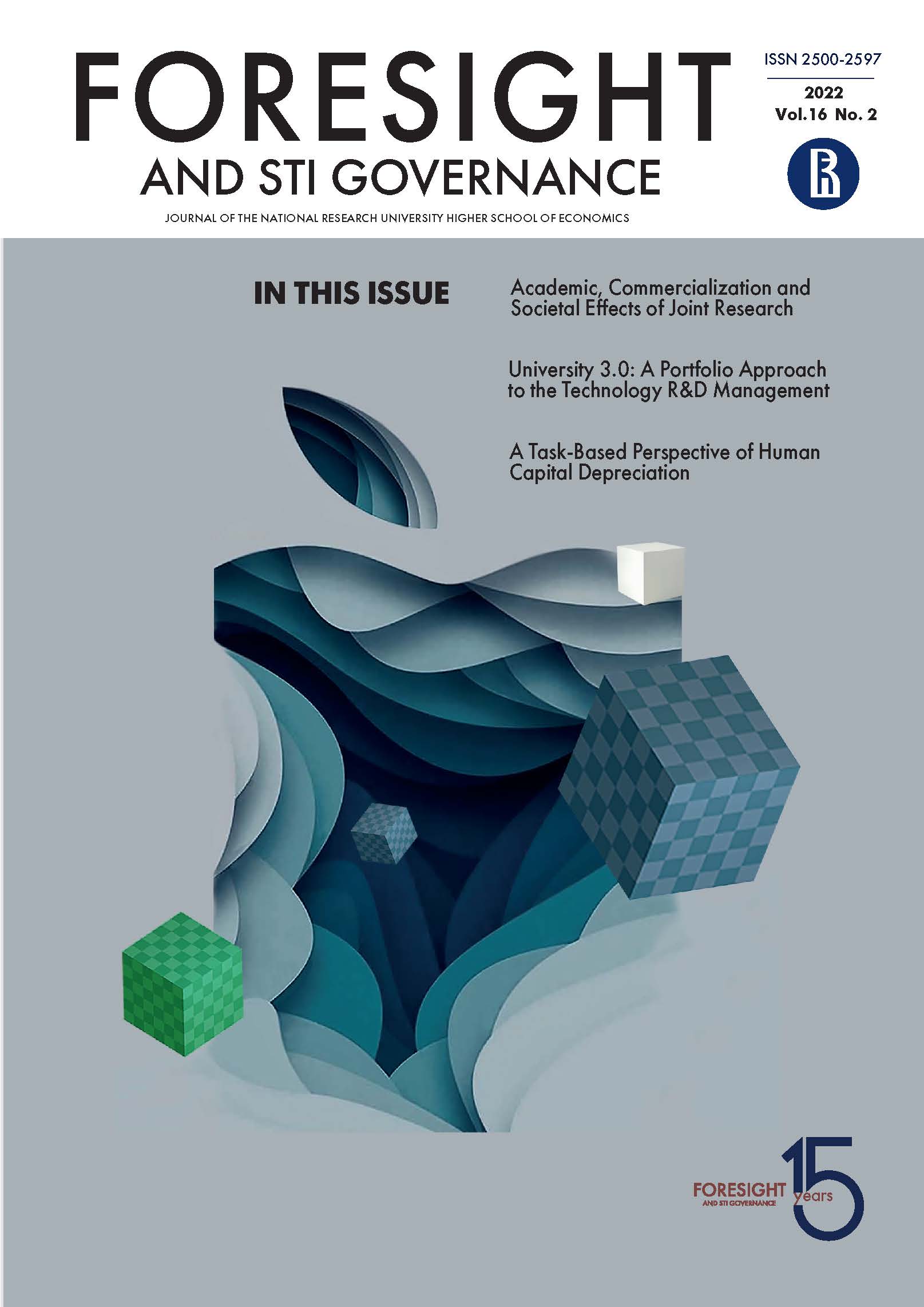Abstract
The work investigates the effects that a specific science industry collaboration scheme, joint research, generates in three areas, such as: production of academic activities, scientific knowledge commercialization and society at large. It is an in-depth work on joint research in a developing country that covers three different types of effects. The work highlights the specific industrial contributions that make it possible such effects to be verified, with special attention to societal effects, an aspect rarely present in the literature. Based on some dimensions that recent literature has identified and where more empirical evidence is needed, a multiple case study has been carried out through the selection of three public private collaborations in Argentine biopharmaceutical sector responding to joint research characteristics. Among the main findings, the identification of the different ways in which relationship with industry allows science: to intensify its publication activity, by having more resources and identifying new thematic niches to publish; to improve teaching, using co-generated knowledge and shared equipment; to expand its research agenda both towards applied topics and towards more basic ones. Likewise, relationship with industry allows knowledge generation that, in addition to being central in the creation of start-ups and patents, also contribute to perform new services of commercial nature. Finally, joint research generates effects that benefit society in general, through cheaper domestic diagnostic or therapeutic solutions improving public health.
References
Ankrah S., Al-Tabbaa O. (2015) Universities-industry collaboration: A systematic review. Scandinavian Journal of Management, 31, 387-408. DOI: https://doi.org/10.1016/j.scaman.2015.02.003
Arza V., Carattoli M. (2017) Personal ties in university-industry linkages: A case-study from Argentina. The Journal of Technology Transfer, 42, 814-840. DOI: https://doi.org/10.1007/s10961-016-9544-x
Banal-Estañol A., Jofre-Bonet M., Lawson C. (2015) The double-edged sword of industry collaboration: Evidence from engineering academics in the UK. Research Policy, 44, 1160-1175. DOI: https://doi.org/10.1016/j.respol.2015.02.006
Beaudry C., Kananian R. (2013) Follow the (industry) money - The Impact of science networks and industry-to-university contracts on academic patenting in nanotechnology and biotechnology. Industry and Innovation, 20, 241-260. DOI: https://doi.org/10.1080/13662716.2013.791125
Bianchini S., Lissoni F., Pezzoni M., Zirulia L. (2016) The economics of research, consulting, and teaching quality: theory and evidence from a technical university. Economics of Innovation and New Technology, 25, 668-691. DOI: https://doi.org/10.1080/10438599.2015.1114340
Bikard M., Vakili K., Teodoridis F. (2019) When collaboration bridges institutions: The impact of university-industry collaboration on academic productivity. Organization Science, 30, 426-445. DOI: https://doi.org/10.1287/orsc.2018.1235
Bruneel J., D'Este P., Salter A. (2010) Investigating The Factors that Diminish the Barriers to University-Industry Collaboration. Research Policy, 39(7), 858-868. DOI: https://doi.org/10.1016/j.respol.2010.03.006
D'Este P., Llopis O., Rentocchini F., Yegros A. (2019) The relationship between interdisciplinarity and distinct modes of university-industry interaction. Research Policy, 48, 103799. DOI: https://doi.org/10.1016/j.respol.2019.05.008
D'Este P., Patel P. (2007) University-industry linkages in the UK: What are the factors determining the variety of interactions with industry? Research Policy, (36)9, 1295-1313. DOI: https://doi.org/10.1016/j.respol.2007.05.002
Ding W., Choi E. (2011) Divergent paths to commercial science: A comparison of scientists' founding and advising activities. Research Policy, 40, 69-80. DOI: https://doi.org/10.1016/j.respol.2010.09.011
Freeman C. (2004) Technological infrastructure and international competitiveness. Industrial and Corporate Change, 13(3), 541-569. DOI: https://doi.org/10.1093/icc/dth022
Fritsch M., Krabel S. (2012). Ready to leave the ivory tower?: Academic scientists' appeal to work in the private sector. The Journal of Technology Transfer, 37, 271-296. DOI: https://doi.org/10.1007/s10961-010-9174-7
Garcia R., Araújo V., Mascarini S., Santos E., Costa A. (2020) How long-term university industry collaboration shapes the academic productivity of research groups. Innovation: Organization and Management, 22(1), 56-70. DOI: https://doi.org/10.1080/14479338.2019.1632711
Hottenrott H., Lawson C. (2017) Fishing for complementarities: Research grants and research productivity. International Journal of Industrial Organization, 51, 1-38. DOI: https://doi.org/10.1016/j.ijindorg.2016.12.004
Hughes A., Kitson M. (2012) Pathways to impact and the strategic role of universities: New evidence on the breadth and depth of university knowledge exchange in the UK and the factors constraining its development. Cambridge Journal of Economics, 36(3), 723-750. DOI: https://doi.org/10.1093/cje/bes017
Hughes A., Lawson C., Salter A., Kitson M., Bullock A., Hughes R.B. (2016) The Changing State of Knowledge Exchange: UK Academic Interactions with External Organizations 2005-2015, London: NCUB.
Iorio R., Labory S., Rentocchini F. (2017) The importance of pro-social behaviour for the breadth and depth of knowledge transfer activities: An analysis of Italian academic scientists. Research Policy, 46(2), 497-509. DOI: https://doi.org/10.1016/j.respol.2016.12.003
Lee Y.S. (2000) The sustainability of university-industry research collaboration: An empirical assessment. Journal of Technology Transfer, 25(2), 111-133. https://doi.org/10.1023/A:1007895322042.
Libaers D. (2017) Time allocations across collaborations of academic scientists and their impact on efforts to commercialize novel technologies: Is more always better? R&D Management, 47, 180-197. DOI: https://doi.org/10.1111/radm.12164
Lundvall B.A. (1997) National Systems and National Styles of Innovation. Paper presented to the Fourth International ASEAT Conference, Manchester, 2-4 September 1997.
Meyer-Krahmer F., Schmoch U. (1998) Science-based technologies: University-industry interactions in four fields. Research Policy, 27(8), 835-851. DOI: https://doi.org/10.1016/S0048-7333(98)00094-8
Milesi D., Verre V., Petelski N. (2017) Science-industry R&D cooperation effects on firm's appropriation strategy: The case of Argentine biopharma. European Journal of Innovation Management, 20(3), 372-391. DOI: https://doi.org/10.1108/EJIM-07-2015-0058
Nelson R. (ed.) (1993) National Innovation Systems: A Comparative Study, Oxford: Oxford University Press.
Perkmann M., Salandra R., Tartari V., McKelvey M., Hughes A. (2021) Academic engagement: A review of the literature 2011-2019. Research Policy, 50(1), 104-114. DOI: https://doi.org/10.1016/j.respol.2020.104114
Perkmann M., Walsh K. (2009) The two faces of collaboration: Impacts of university-industry relations on public research. Industrial and Corporate Change, 18(6), 1033-1065. DOI: https://doi.org/10.1093/icc/dtp015
Schartinger D., Rammer C., Fischer M.M., Frohlich J. (2002) Knowledge interactions between universities and industry in Austria: Sectoral patterns and determinants. Research Policy, 31(3), 303-328. DOI: https://doi.org/10.1016/S0048-7333(01)00111-1
Stake R. (1995) Investigación con estudios de caso, Madrid: Ediciones Morata (in Spanish).
Van Looy B., Callaert J., Debackere K. (2006) Publication and patent behavior of academic researchers: Conflicting, reinforcing or merely co-existing? Research Policy, 35(4), 596-608. DOI: https://doi.org/10.1016/j.respol.2006.02.003
Verre V., Milesi D., Petelski N. (2021) Science-Industry Cooperation: What Are the Benefits for the Public Part? Evidence from Argentine Biopharmaceutical Sector. International Journal of Innovation and Technology Management, 18(3), 1-22. DOI: https://doi.org/10.1142/S0219877021500073
Yin R.K. (2009) Case study research and applications: Design and methods, Thousand Oaks, CA: Sage Publications.

This work is licensed under a Creative Commons Attribution 4.0 International License.


